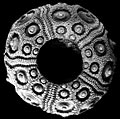The Echinoid Directory
Almucidaris Blake & Zinsmeister, 1991, p. 632
| Diagnostic Features |
|
|---|---|
| Distribution | Upper Cretaceous (Maastrichtian); Antarctic and Spain. |
| Name gender | feminine |
| Type | Almucidaris durhami Blake & Zinsmeister, 1991, p. 632, by original designation. |
| Species Included |
|
| Classification and/or Status |
|
| Remarks |
|



